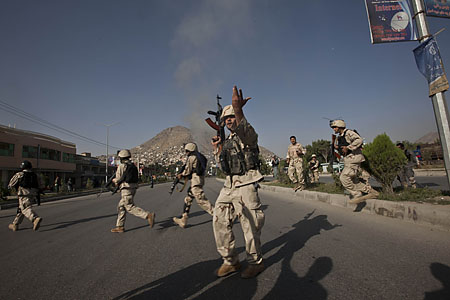
Afghan special police forces arrive at the site of a suicide attack outside The British Council in Kabul, Afghanistan, August 19, 2011. (Photo: Dar Yasin / AP)
When suicide bombers attack, the knee jerk response from officials in NATO and the U.S. Military is that the tactic is a sign of desperation and weakness, and that insurgents would only use it because they have exhausted all other alternatives. Well, it looks like the Taliban are getting pretty good at desperation. Friday morning’s complex attack on the British Council in Kabul, a nondescript building in a residential area of the capital, followed a familiar pattern—according to the city’s criminal investigation department, one attacker detonated himself at the gate with a carload of explosives at a nearby roundabout, breaching the compound wall and allowing the other attackers access inside. A second suicide bomber detonated inside, and according to police a third and possibly fourth continued to exchange gunfire with security personnel several hours after the initial explosion. It’s not clear what exactly they were after. The British council is an educational institution that offers cultural and linguistic courses to Afghan nationals. And so early in the morning, it is unlikely that any British citizens would have been present. (According to the AP, Afghan officials said at least 10 people have been killed, including all the insurgents. Afghan authorities said at least eight Afghan policemen and a foreign security official – reportedly a New Zealand special services soldier – were killed.). August 19th marks the anniversary of Afghan independence from the British in 1919, though so far the Taliban, while taking credit for the attack, have not said that they chose the site for its symbolic resonance.
While the death toll may have been mercifully low this time around, today’s attack caps a weeklong rampage that has seen some four dozen Afghans killed by insurgents across the country. On Thursday a pair of roadside mines planted in two different villages in the western province of Herat killed 24. In Paktia, south of Kabul, a suicide bomber attempted to ram his explosive laden vehicle into the gates of a US military base, killing two Afghan security guards and nine Afghan laborers standing outside. On Wednesday in the southern province of Oruzgan, a motorcycle bomb detonated in a market, killing five, while two others were killed in Helmand by a roadside bomb. Tuesday saw the drive-by shooting of a young Afghan woman in Kandahar who was on her way to work. And on Sunday, three afghan security guards were killed when the Taliban attempted, and failed, to enter a Kandahar fuel depot with an explosives-laden truck.
(PHOTOS: The Battle Against the Taliban)
These attacks, combined with numbers from a recent UN report detailing civilian casualties in Afghanistan for the first half of 2011, offer a searing challenge to U.S. and NATO assertions that the country is moving towards greater stability. Nearly 1500 non-combatants died, up 15% from the same period last year, and the UN attributes at least 80% of those deaths to insurgent attacks. (The Taliban, of course, deny this, but according to the UN report, the increase is largely due to Improvised Explosive Devices and suicide attackers who fail to reach their intended targets, and detonate among civilians instead). As Erica Gaston of the Open Society Institute points out in a recent post on Foreign Policy “the statistics are a grim reality check to over-optimistic reports by international military and civilian leaders that their strategy is successfully disrupting insurgent activities.” That strategy has evolved from the winning-hearts-and-minds counter insurgency doctrine of 2008-2010 into a full embrace of targeted kill-and-capture operations, including the very unpopular night raids—some 20 a night on average, Gaston estimates. Yet the supposed success of those raids has done little to decrease the violence; 2011 is by far the bloodiest year since the start of the war.
(MORE: Afghan Counterinsurgency: When Everything Is Personal)
If anything, the significant increase in suicide attacks is less a sign of desperation than an indication that the Taliban are so confident in their ability to recruit “martyrdom” volunteers that they are willing to expend them on dubious targets at a time of the day when they are least likely to get the foreign casualties they so covet. So even if the Taliban didn’t intentionally pick a British target on the anniversary of Afghanistan’s independence from Britain, there is still strong symbolism in today’s attack: The Taliban are in the capital, and they can strike where they want, when they want. For residents of Kabul, and Afghanistan at large, that hardly seems like a sign of weakness.
(PHOTOS: Coalition Raid Ends Attack on a Kabul Hotel)
Aryn Baker is TIME’s Middle East Bureau Chief, based in Beirut. Find her on Twitter at @arynebaker. You can also continue the discussion on TIME’s Facebook pageand on Twitter at @TIMEWorld.

